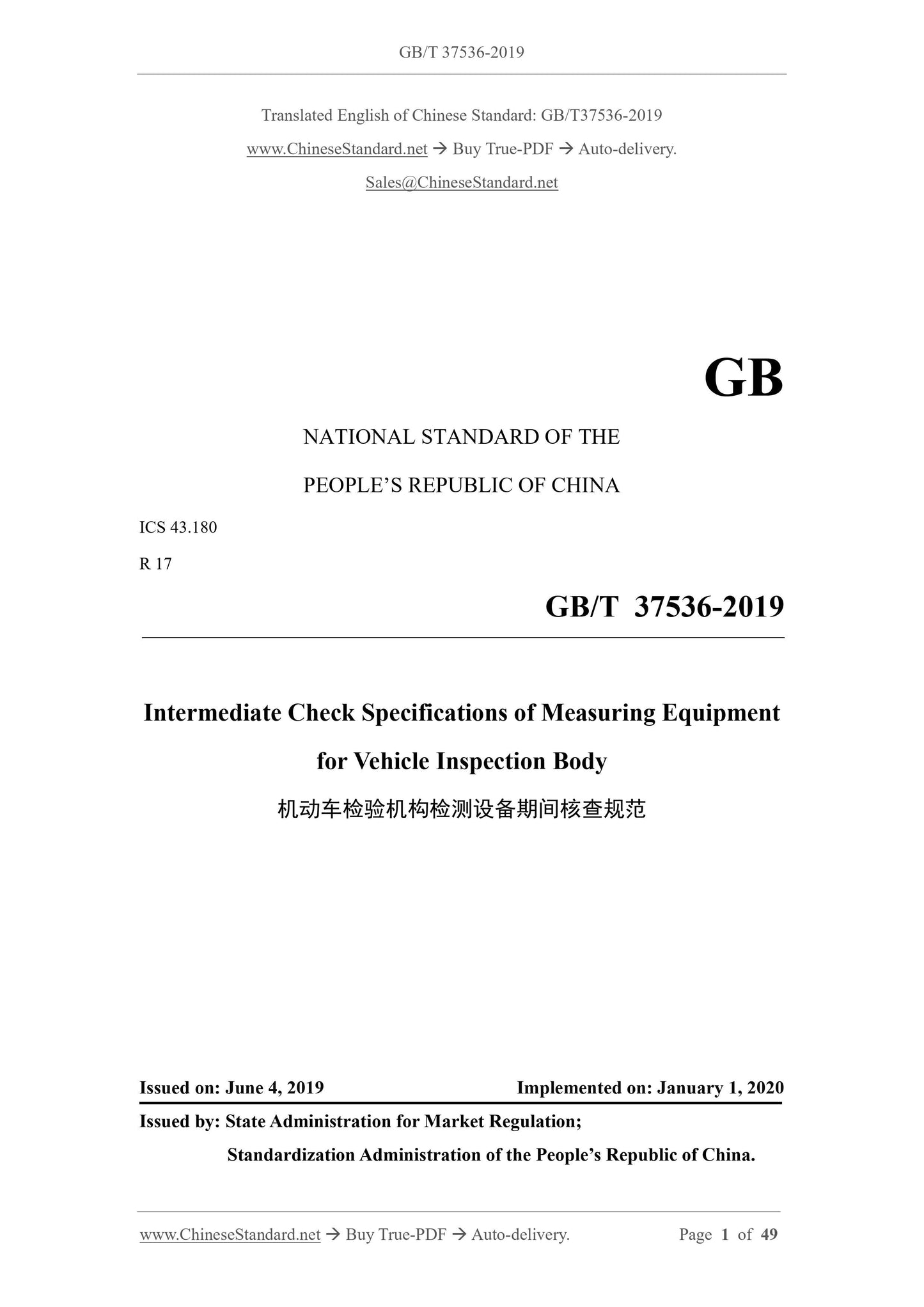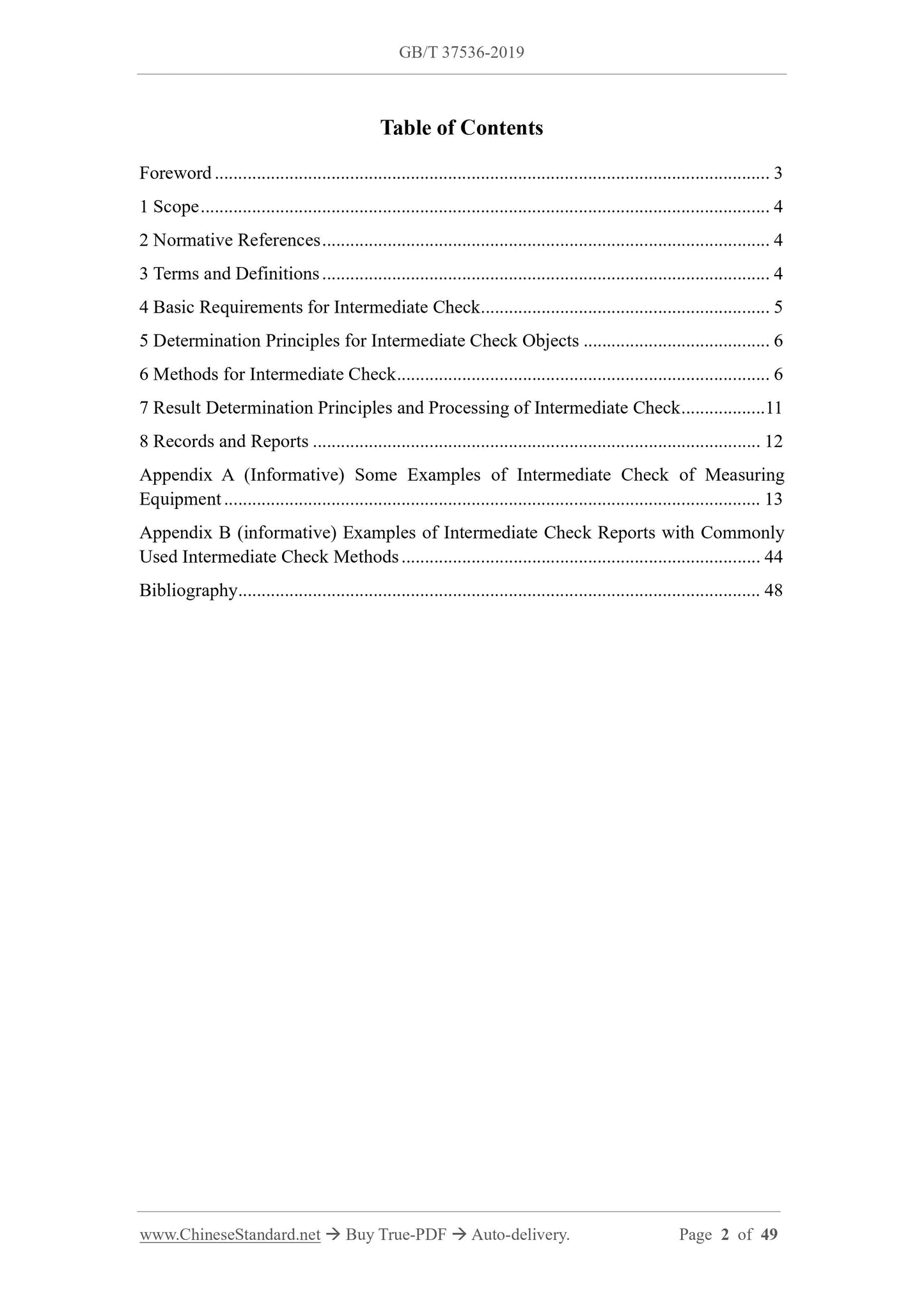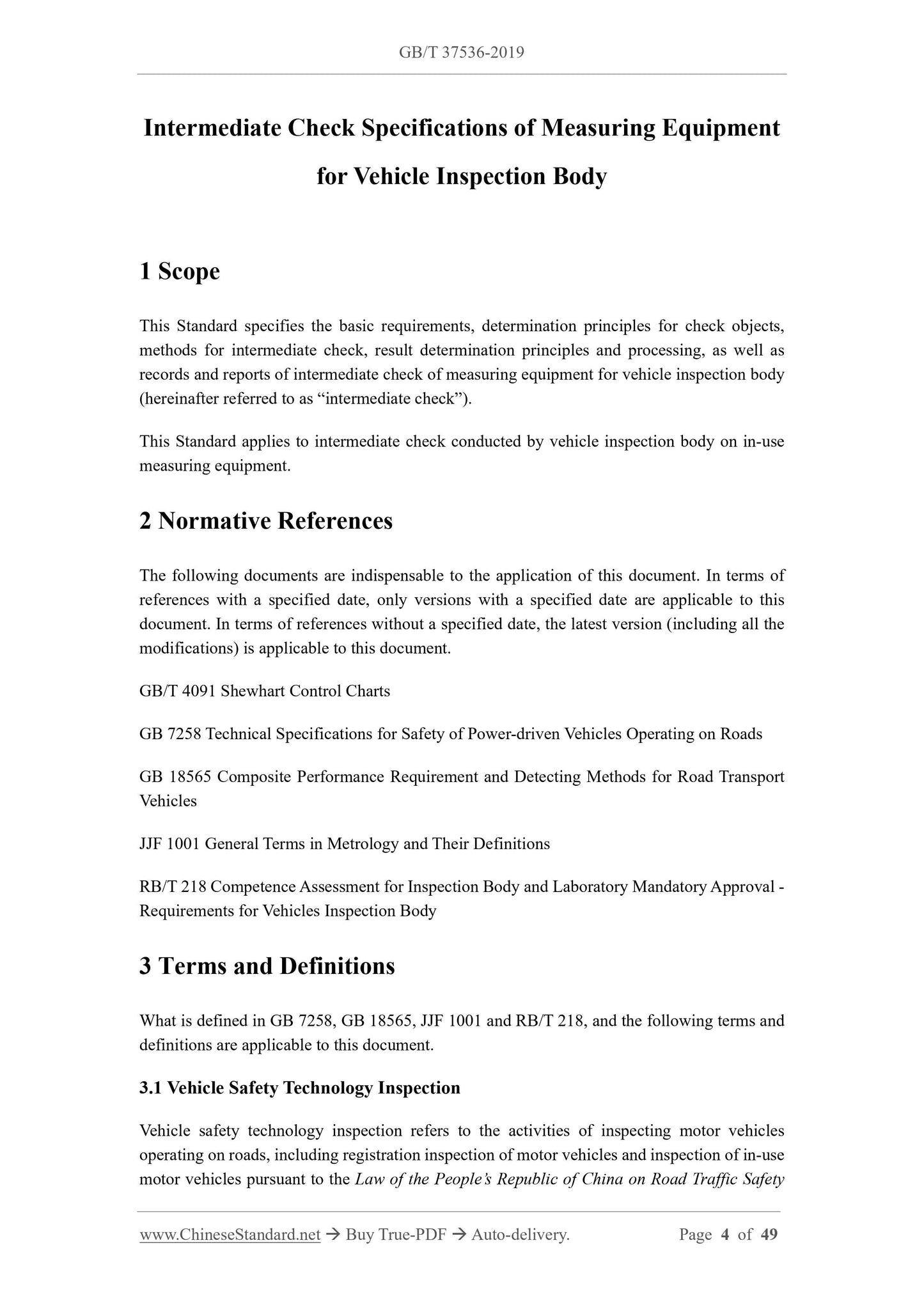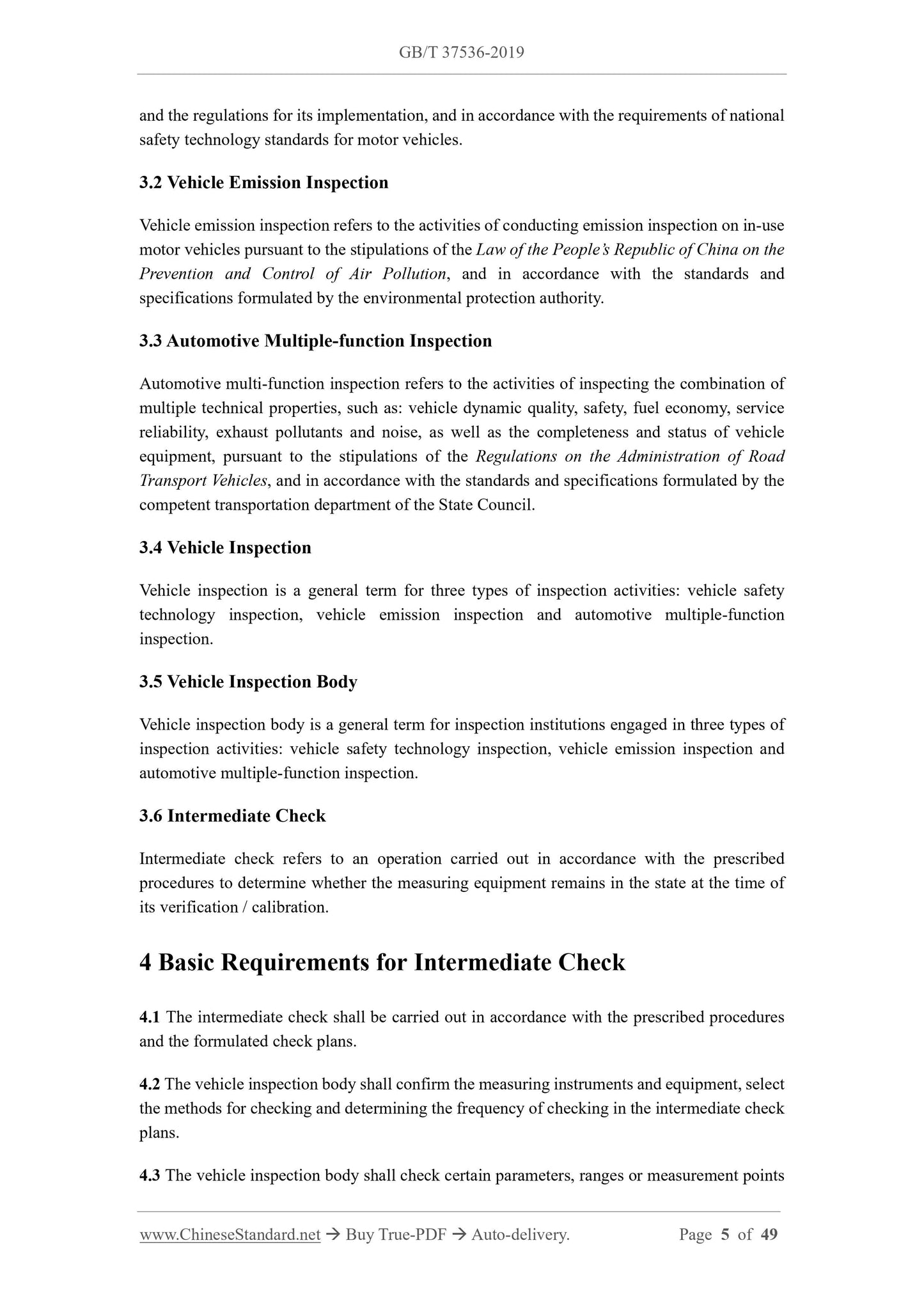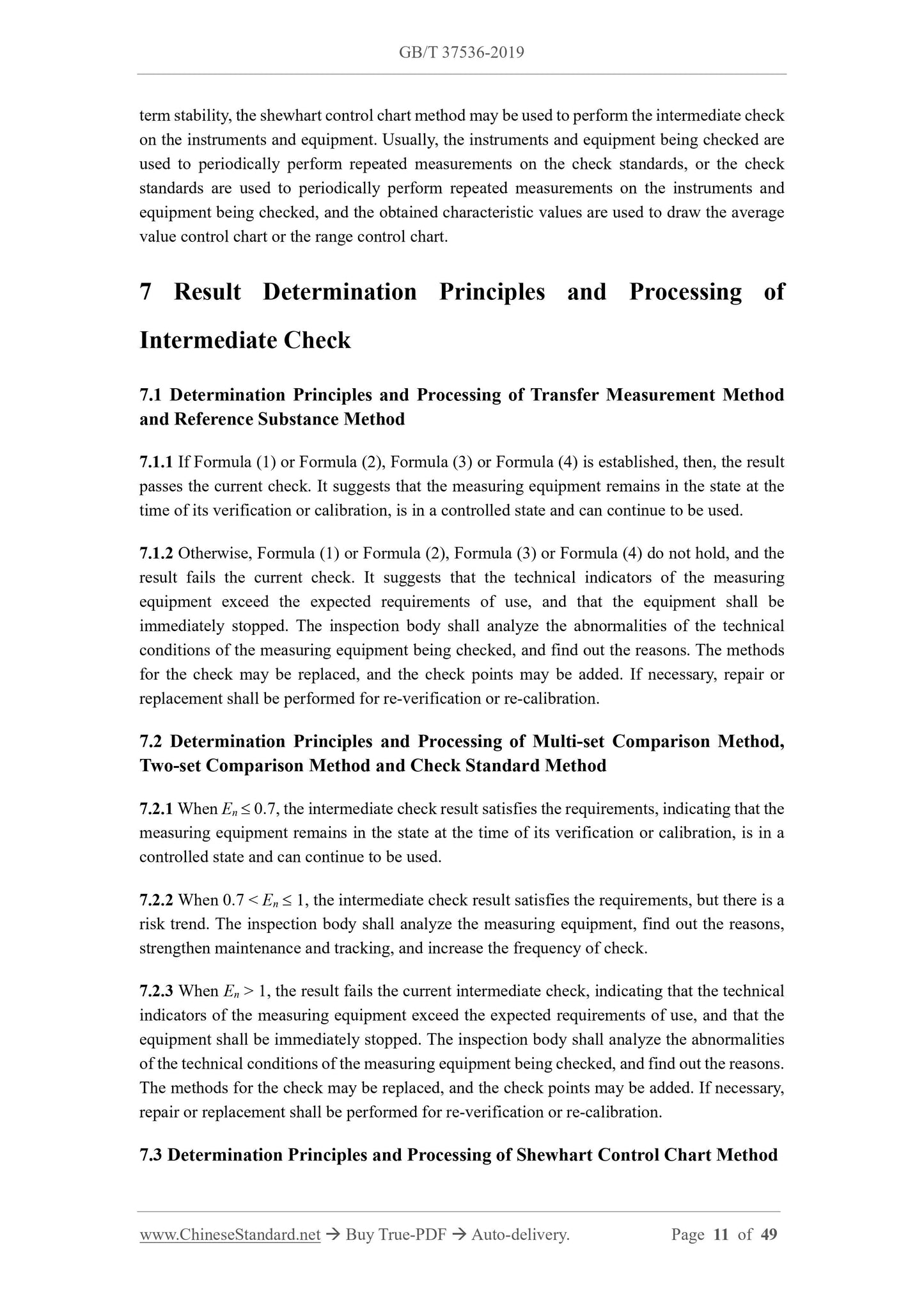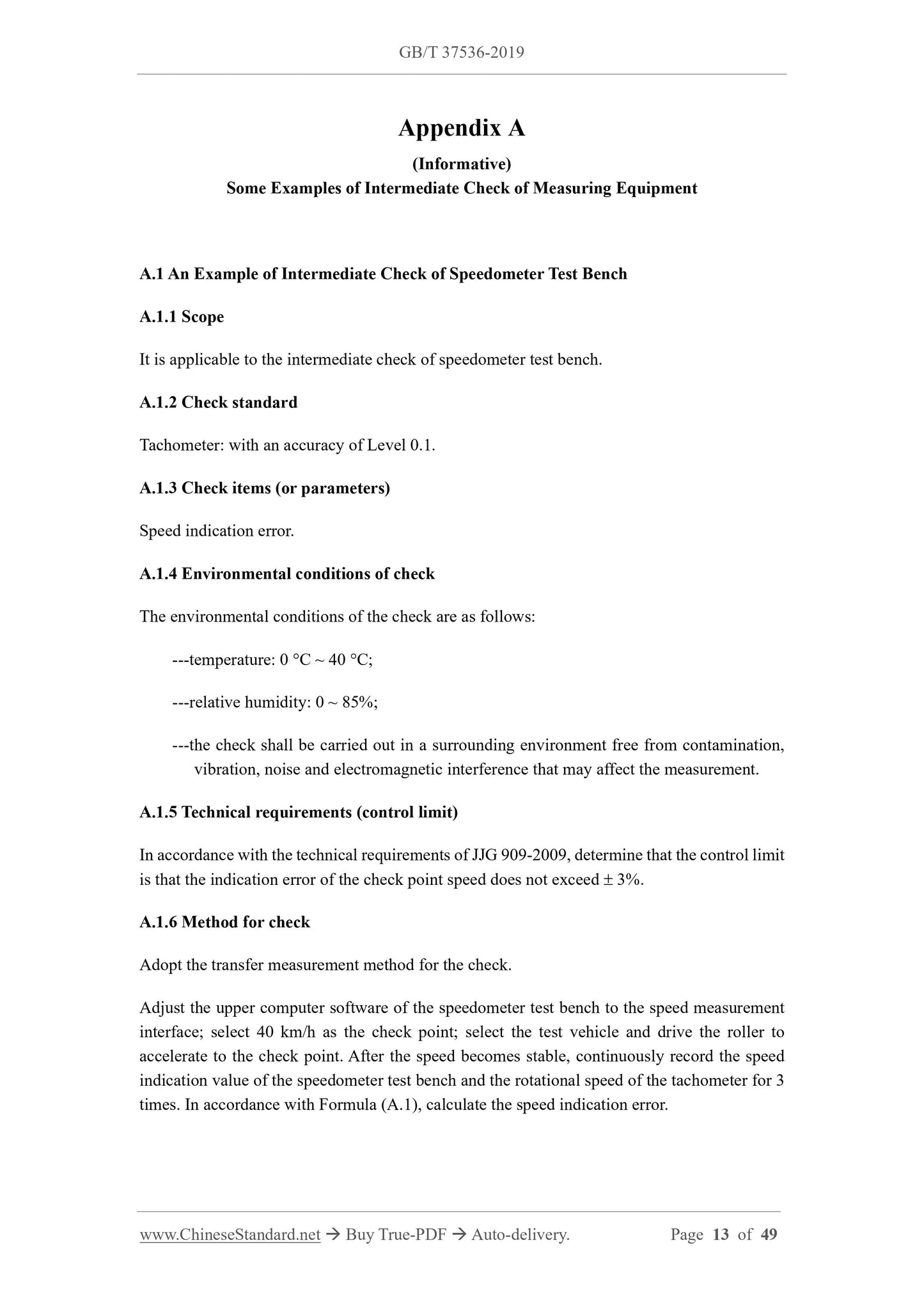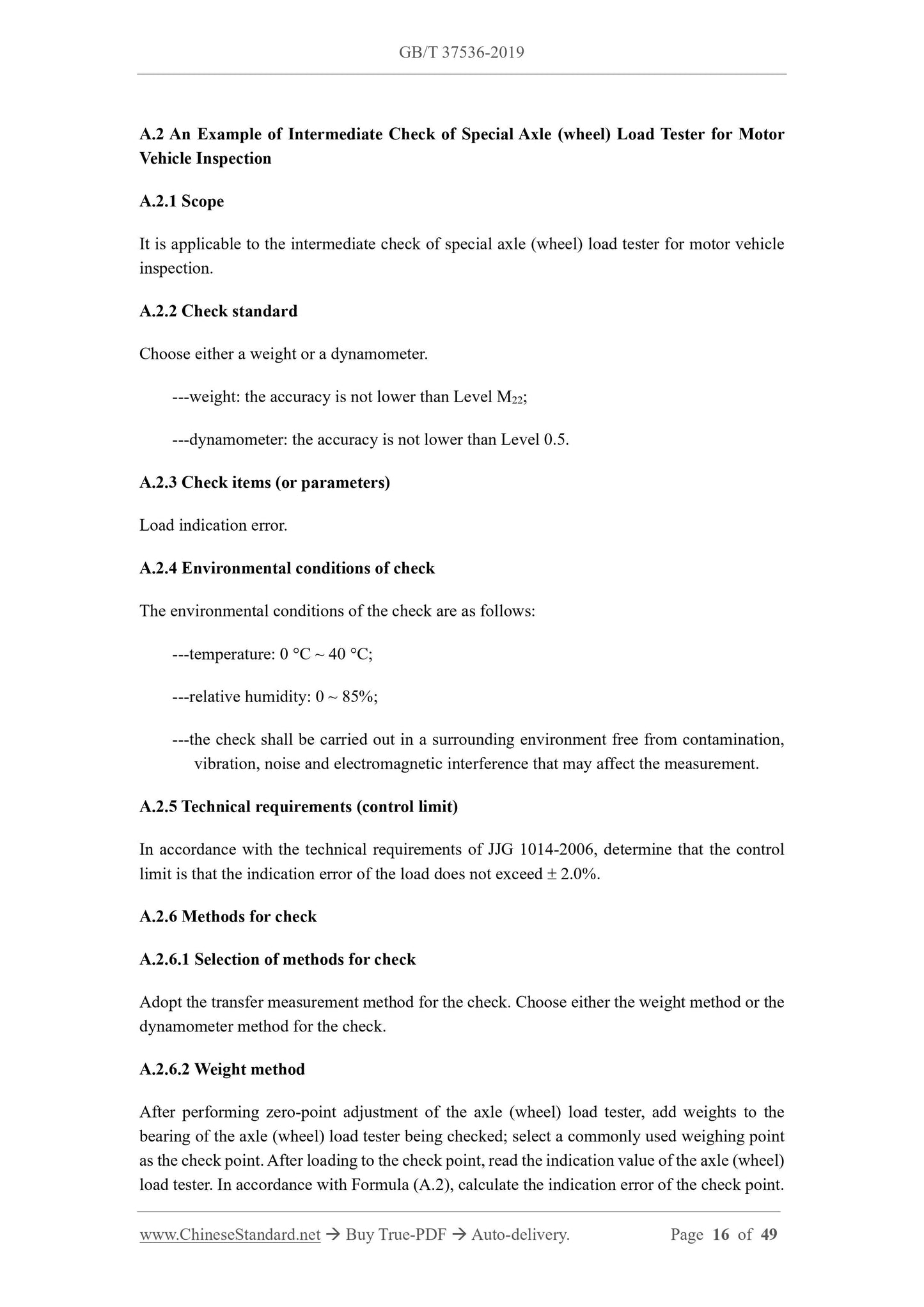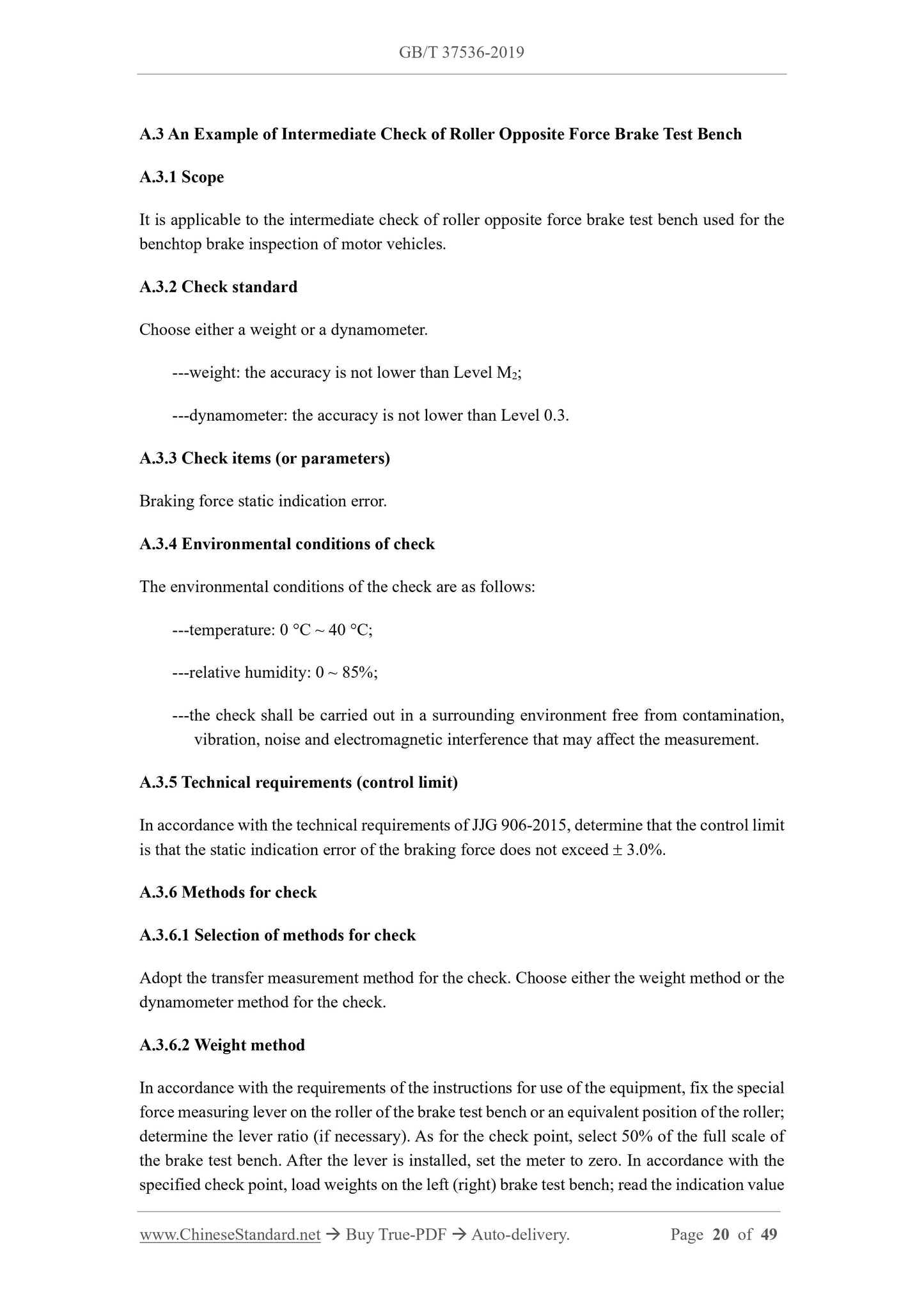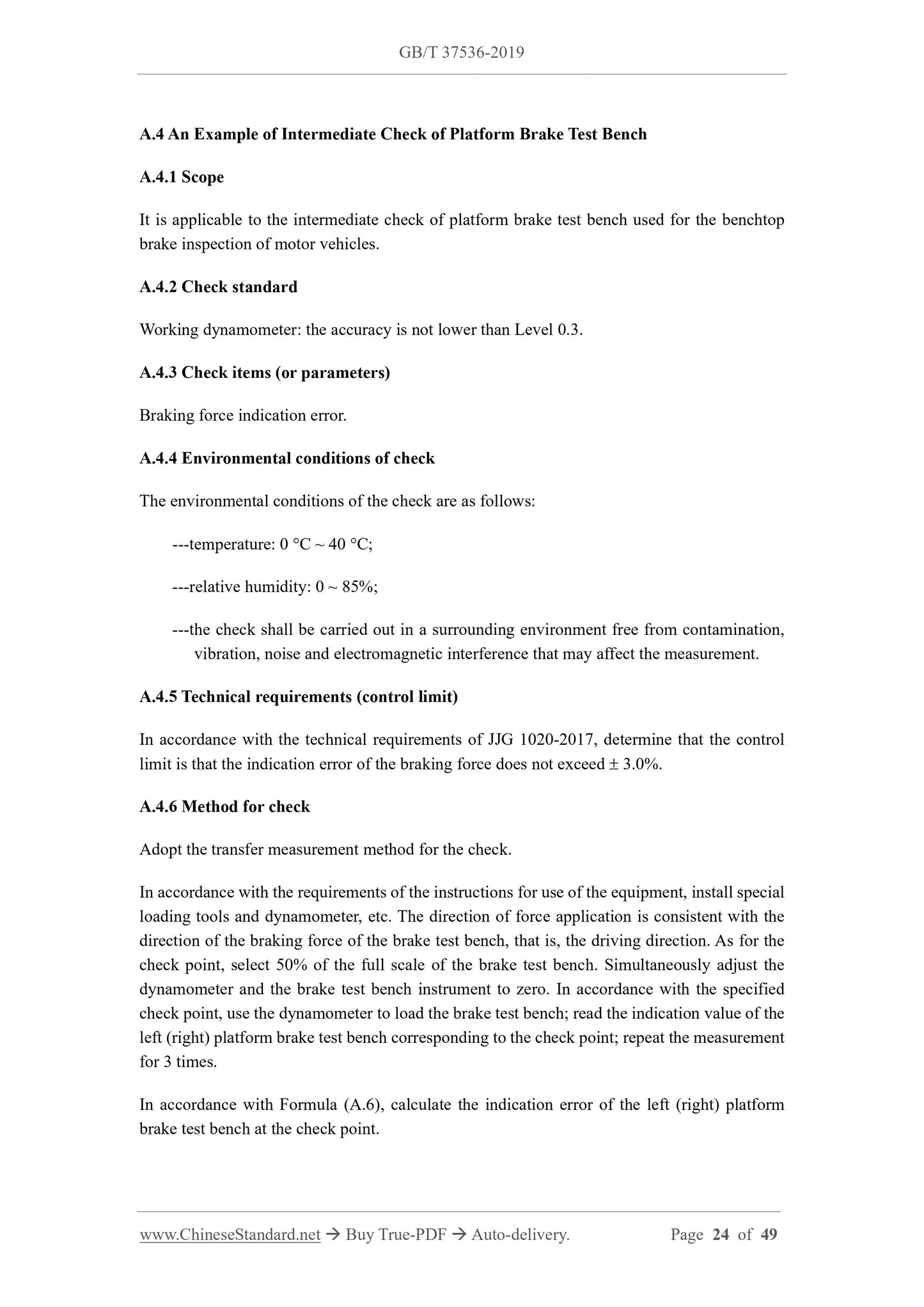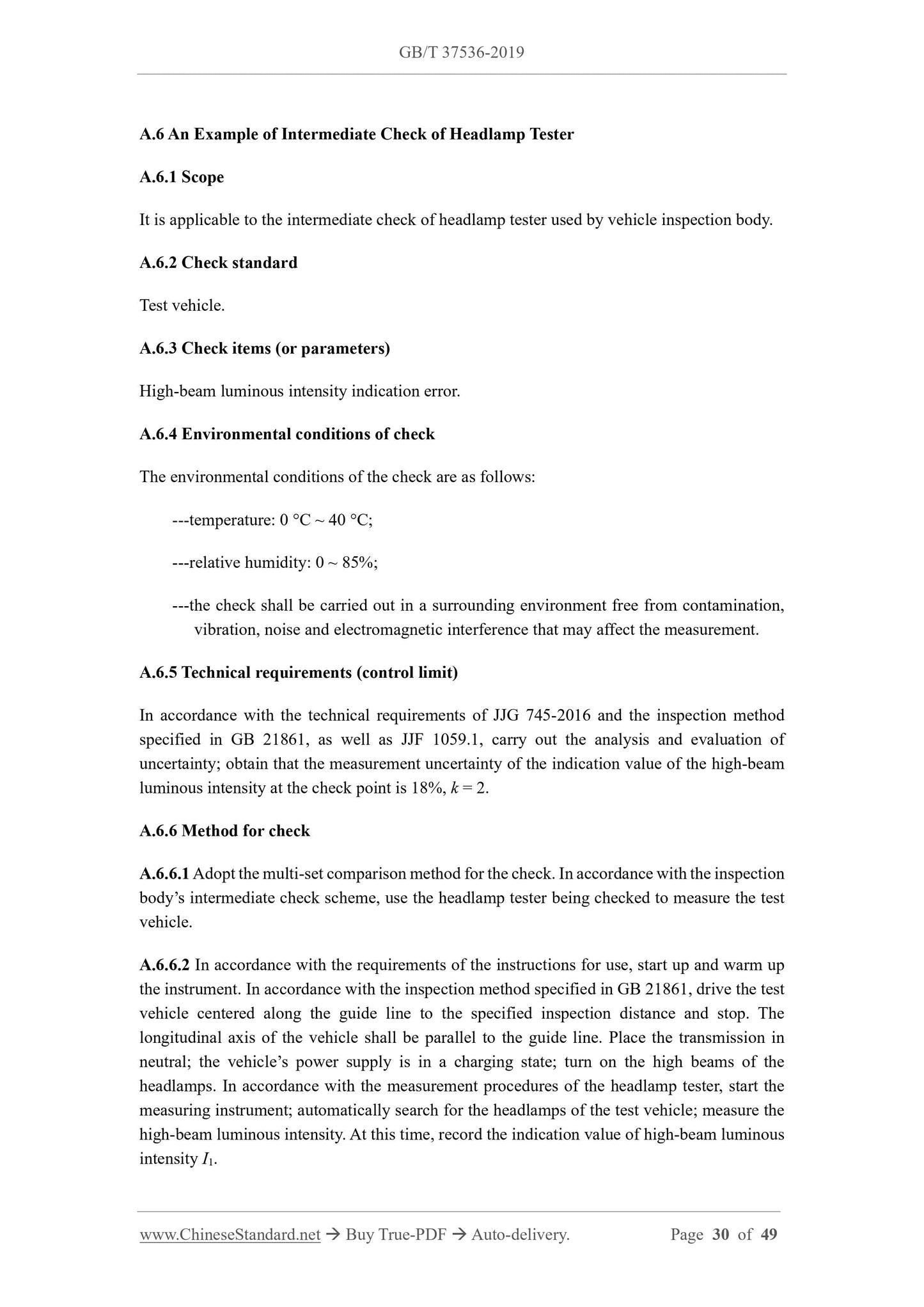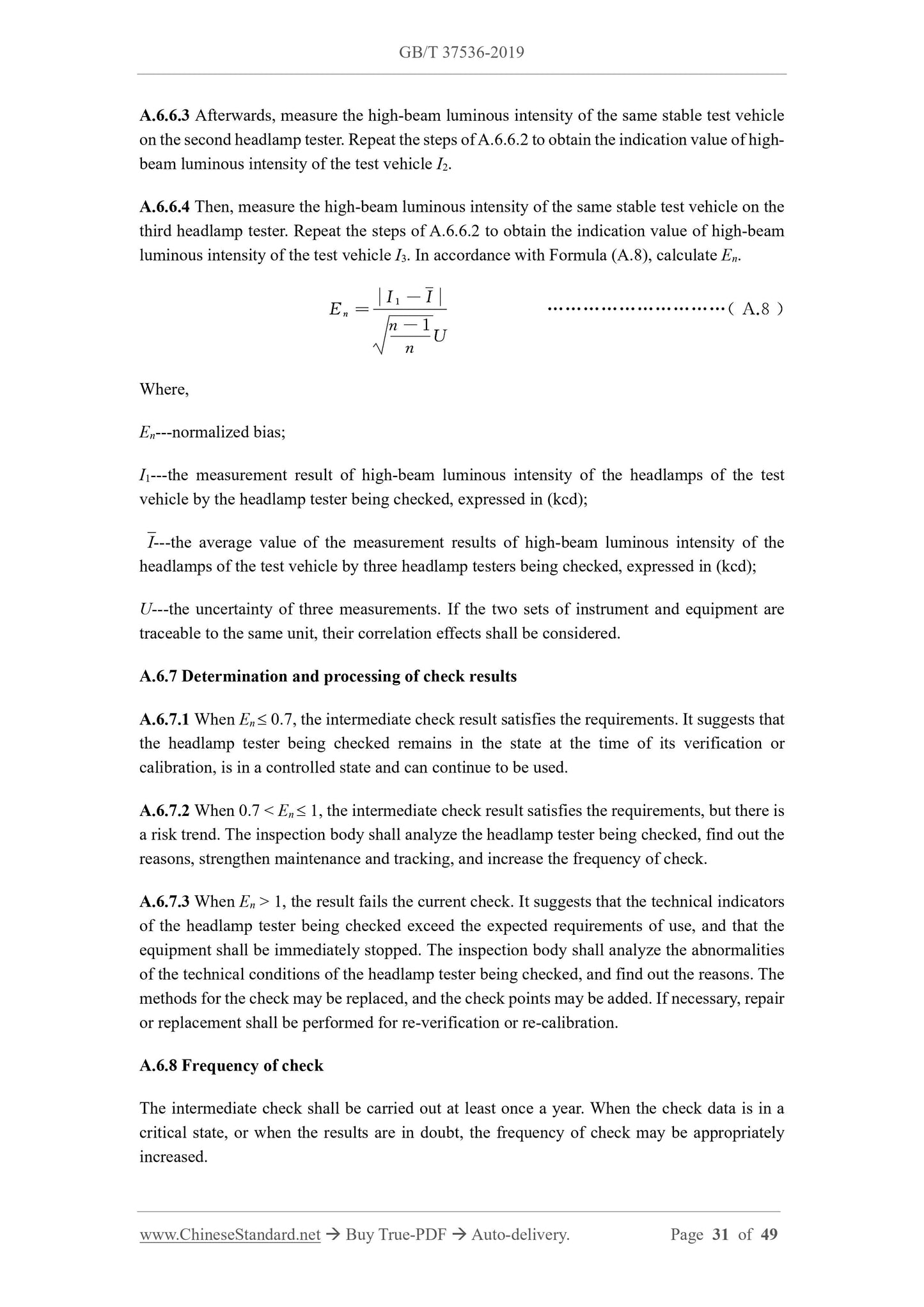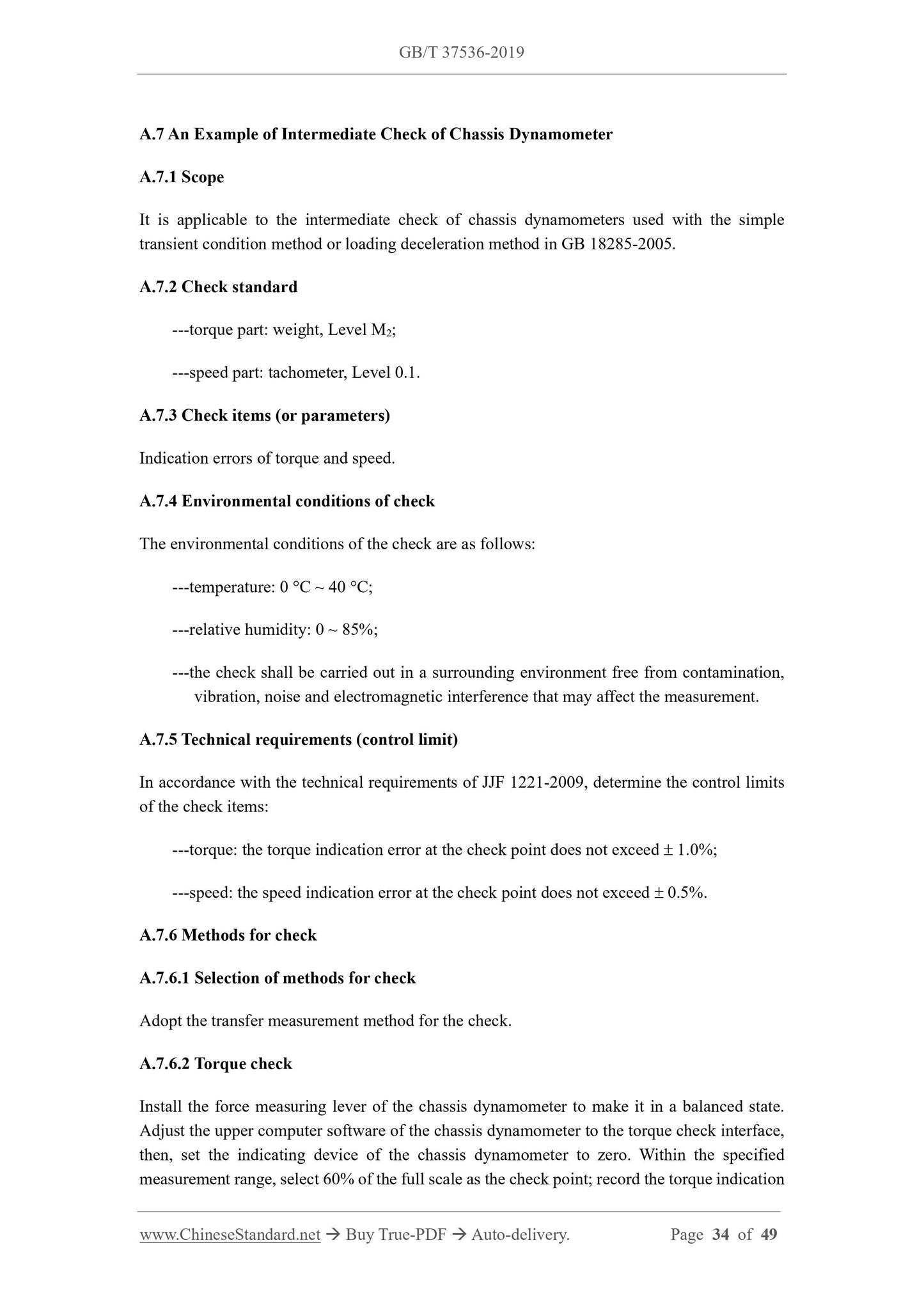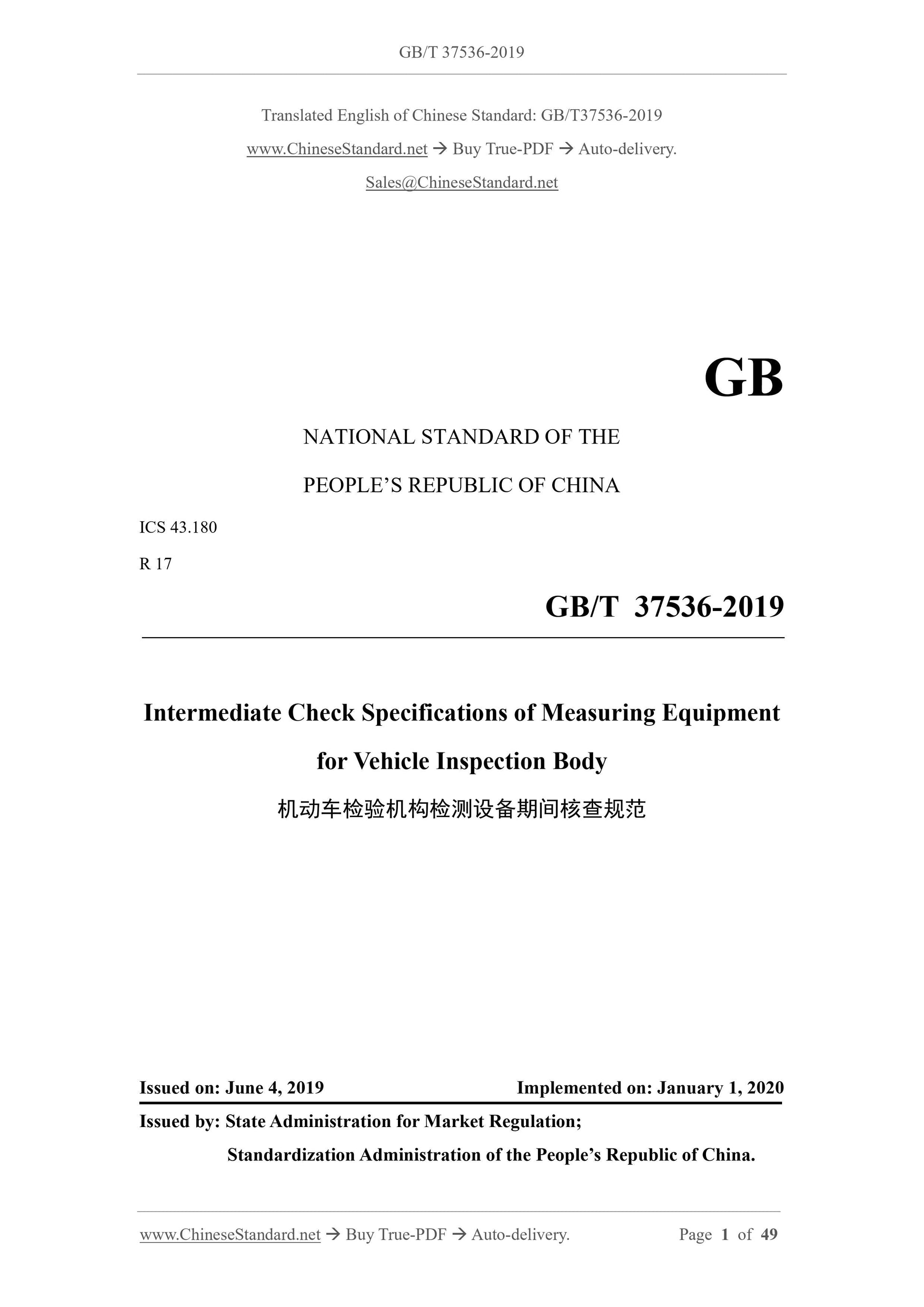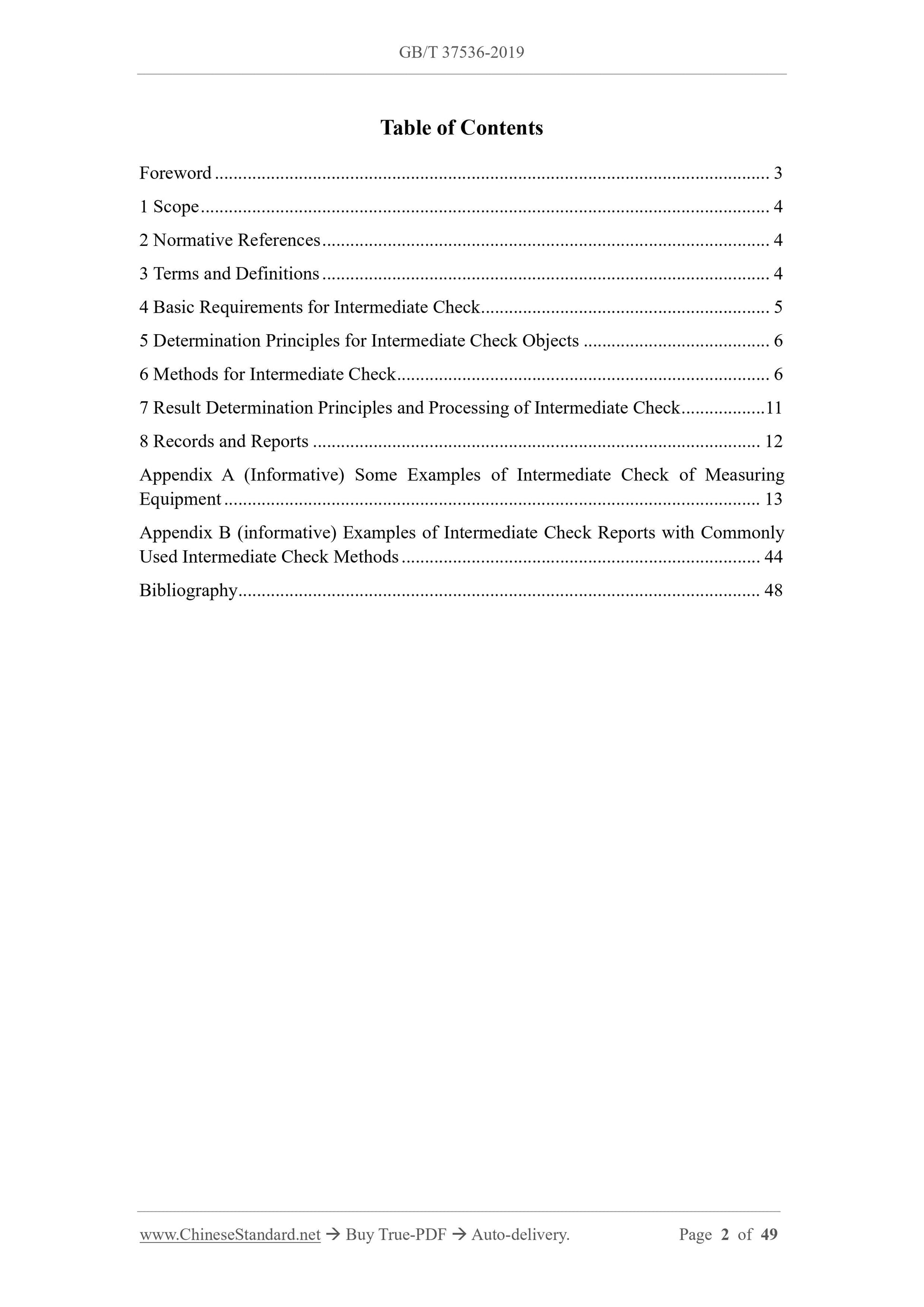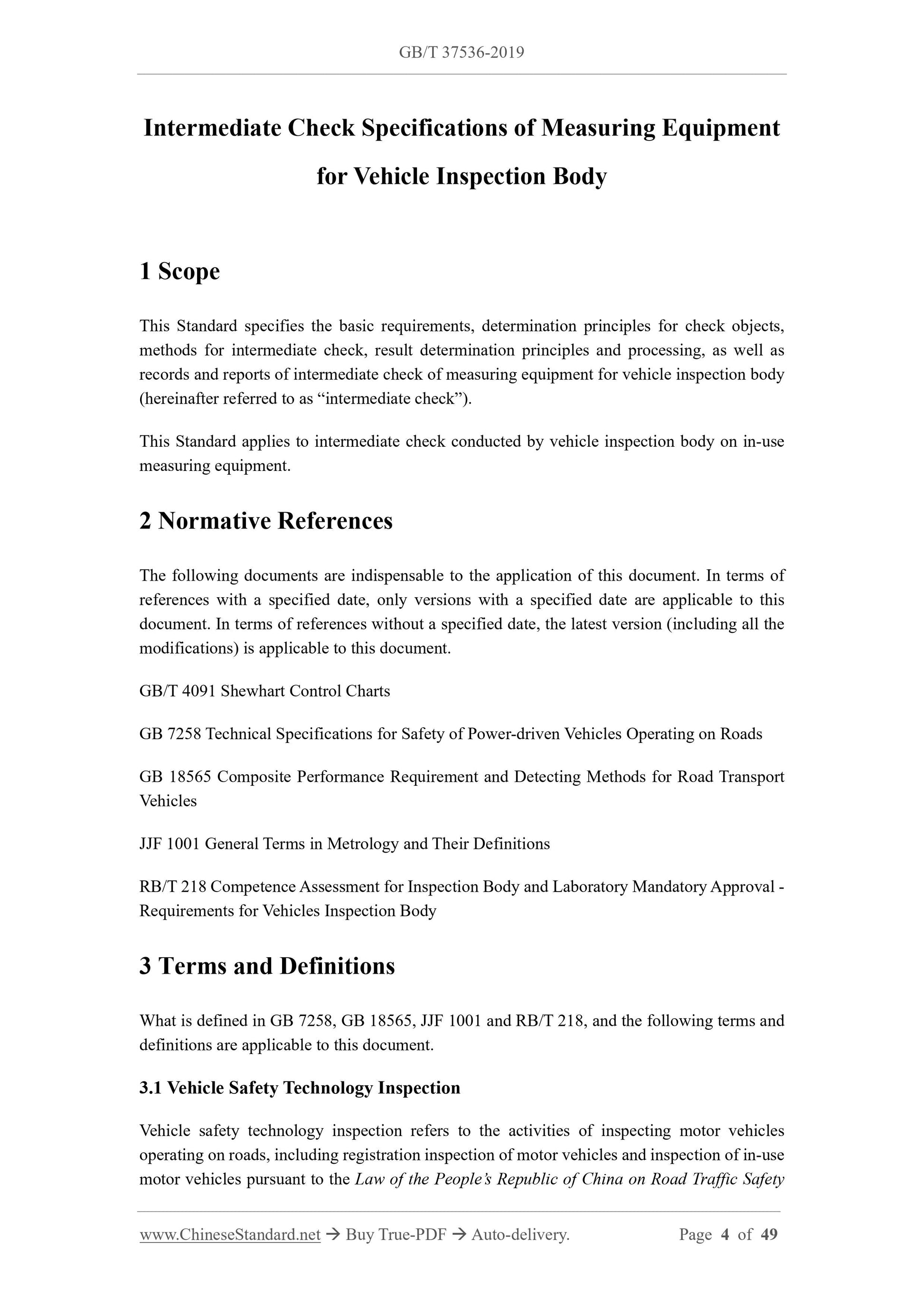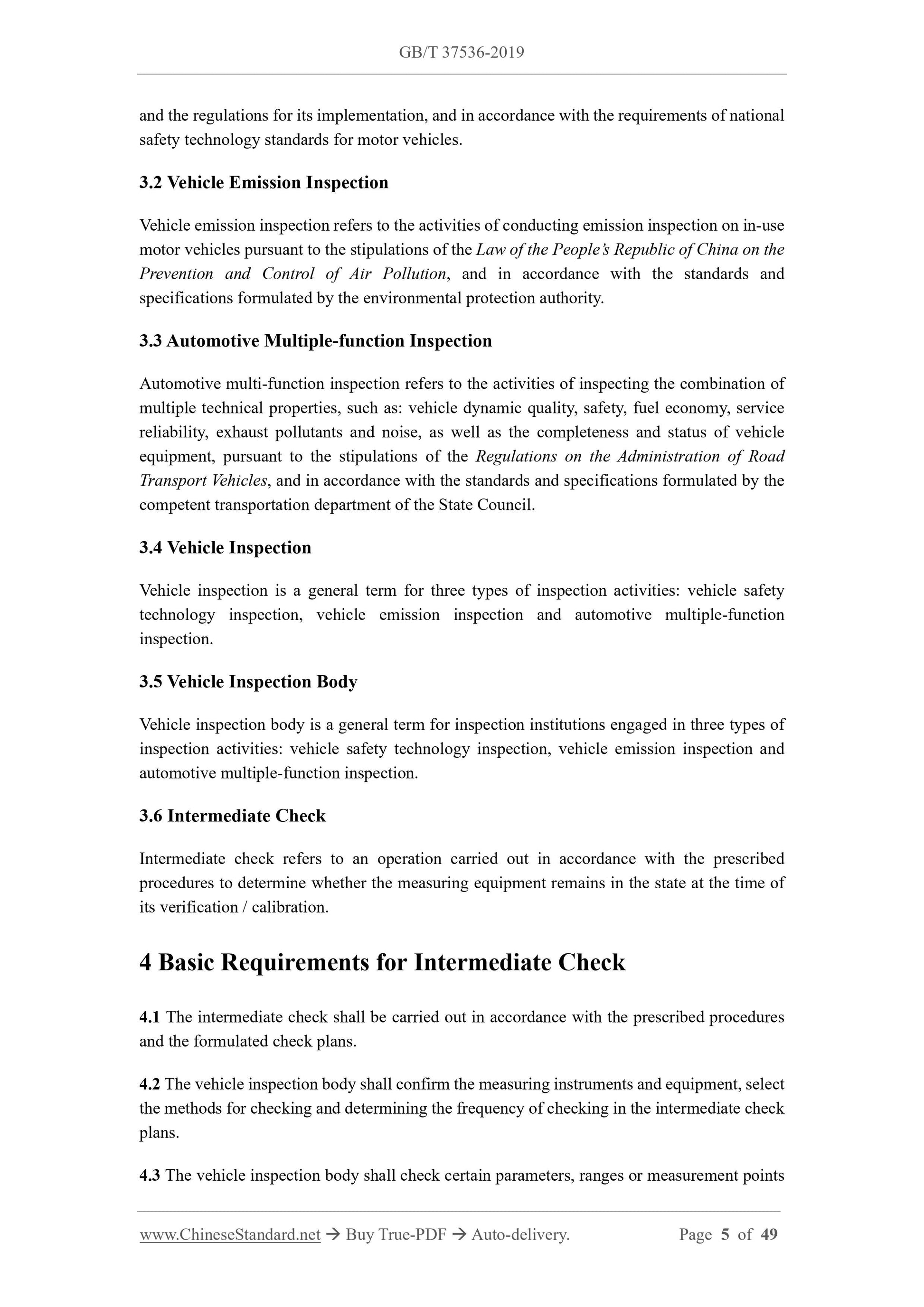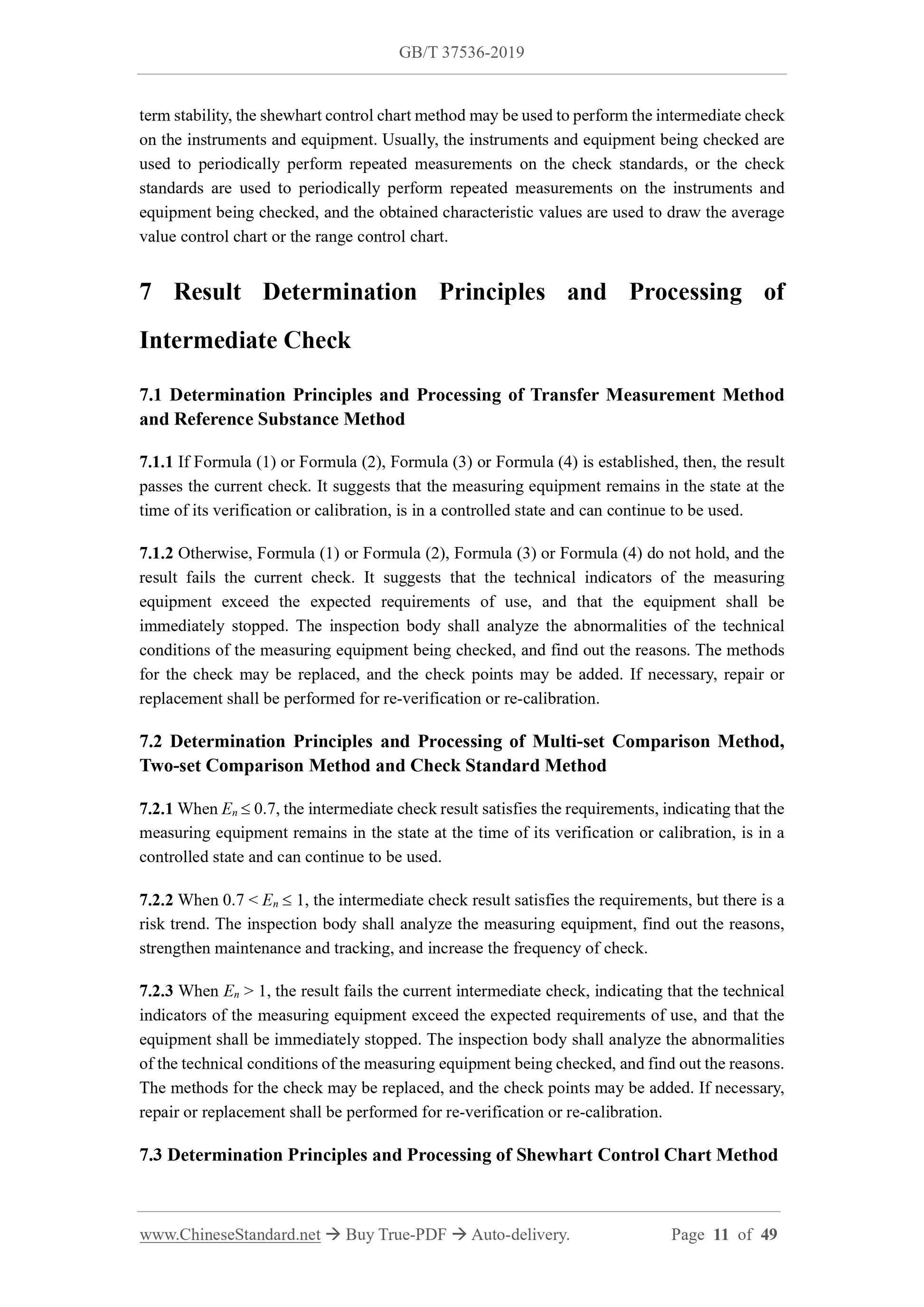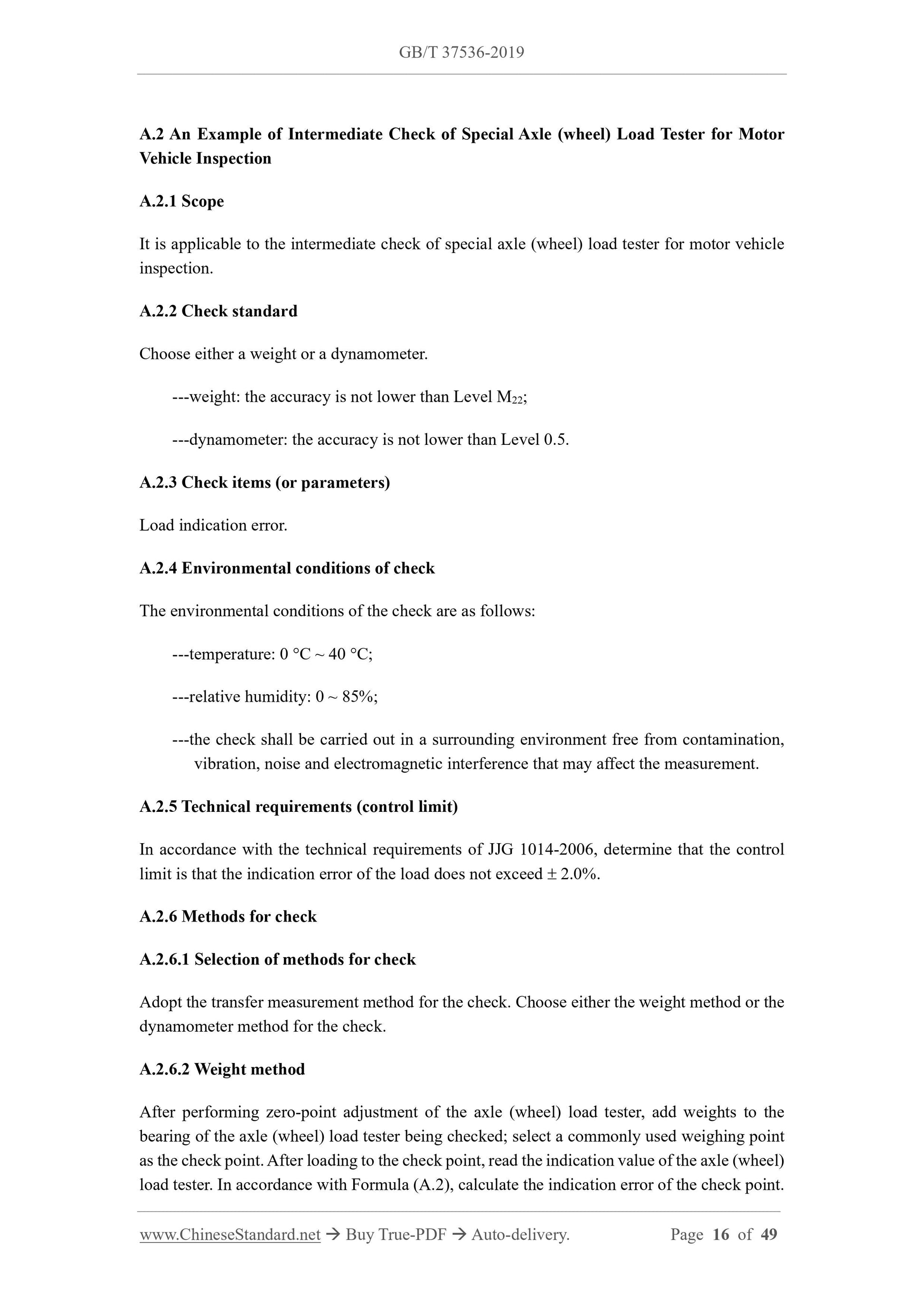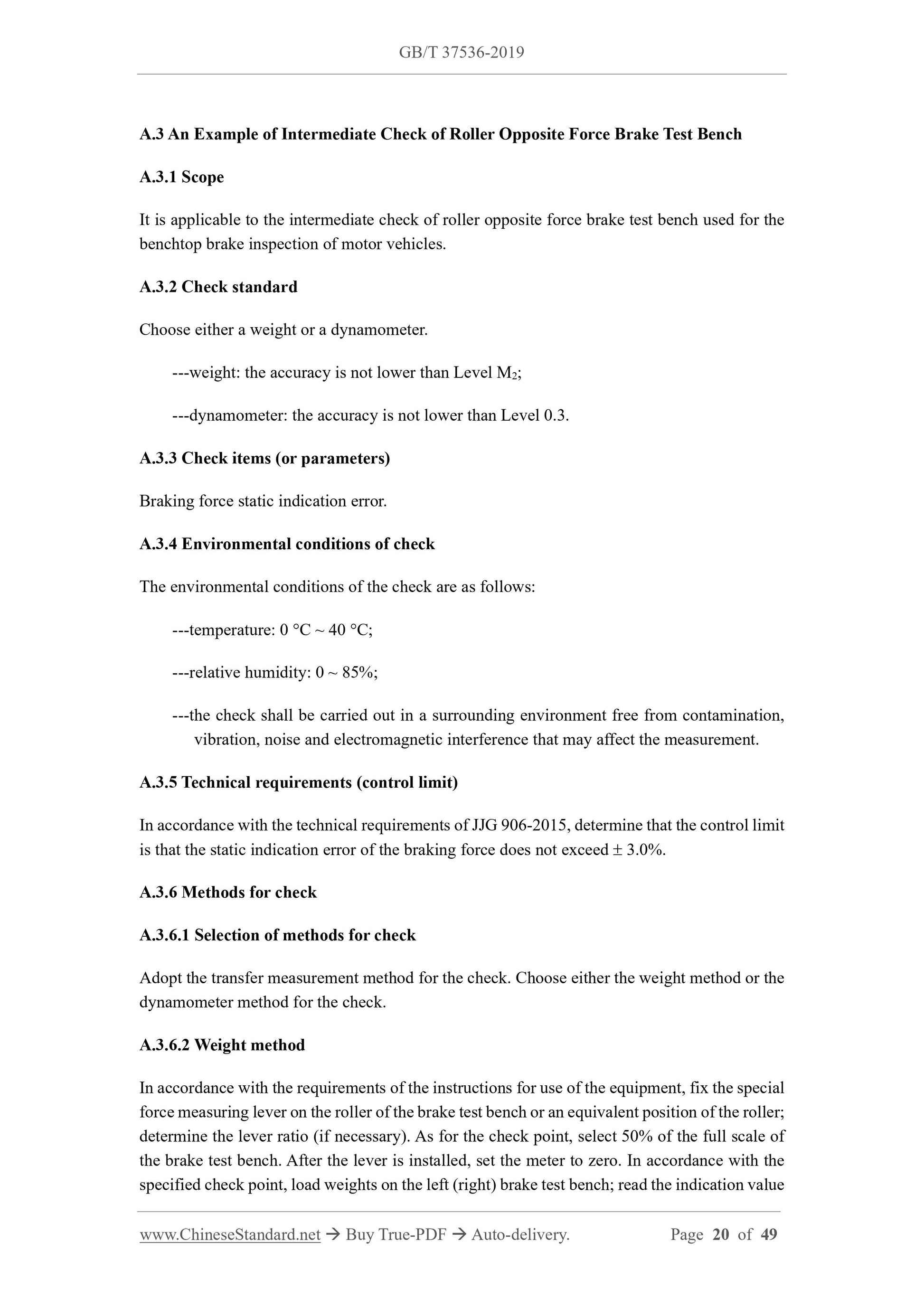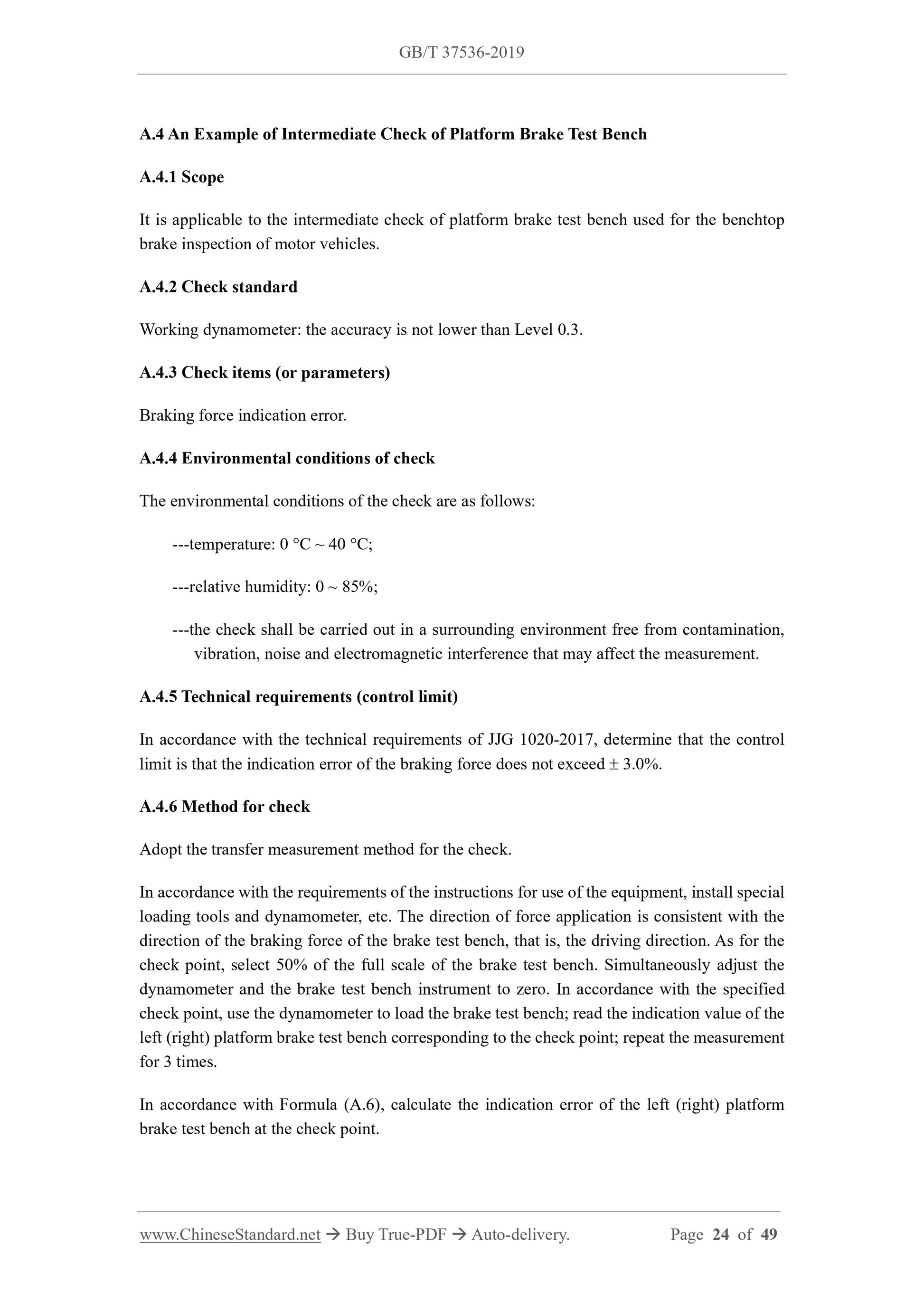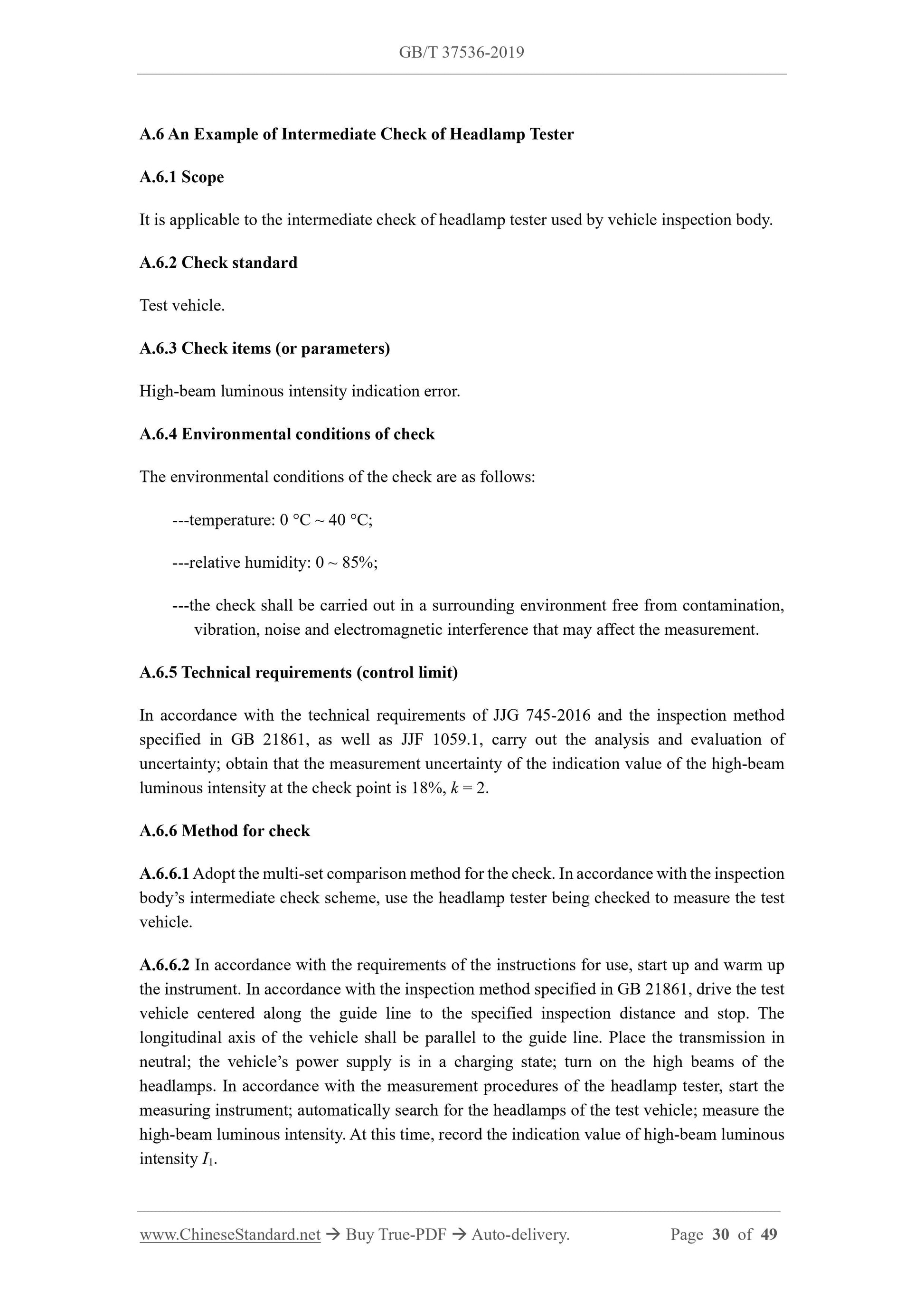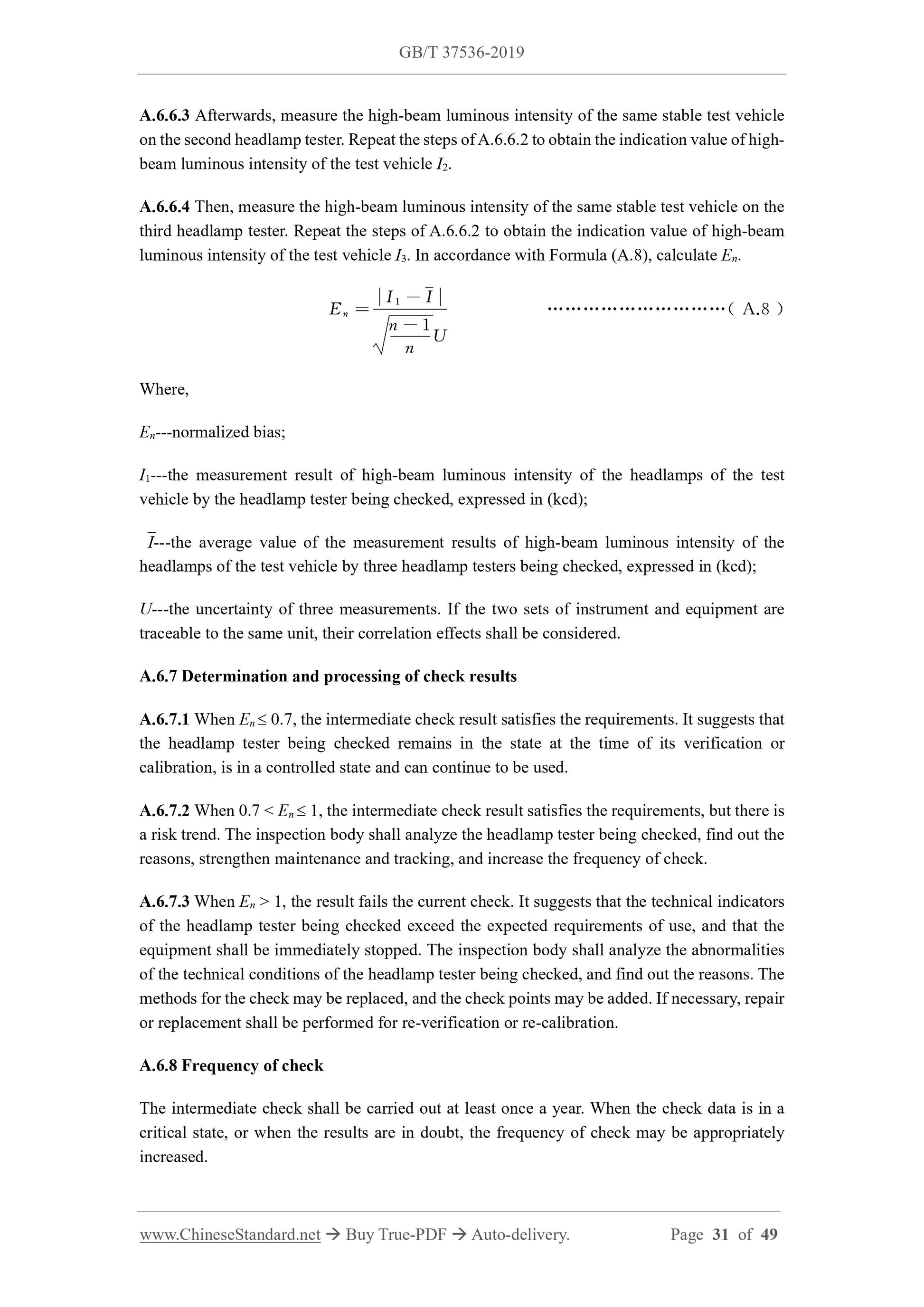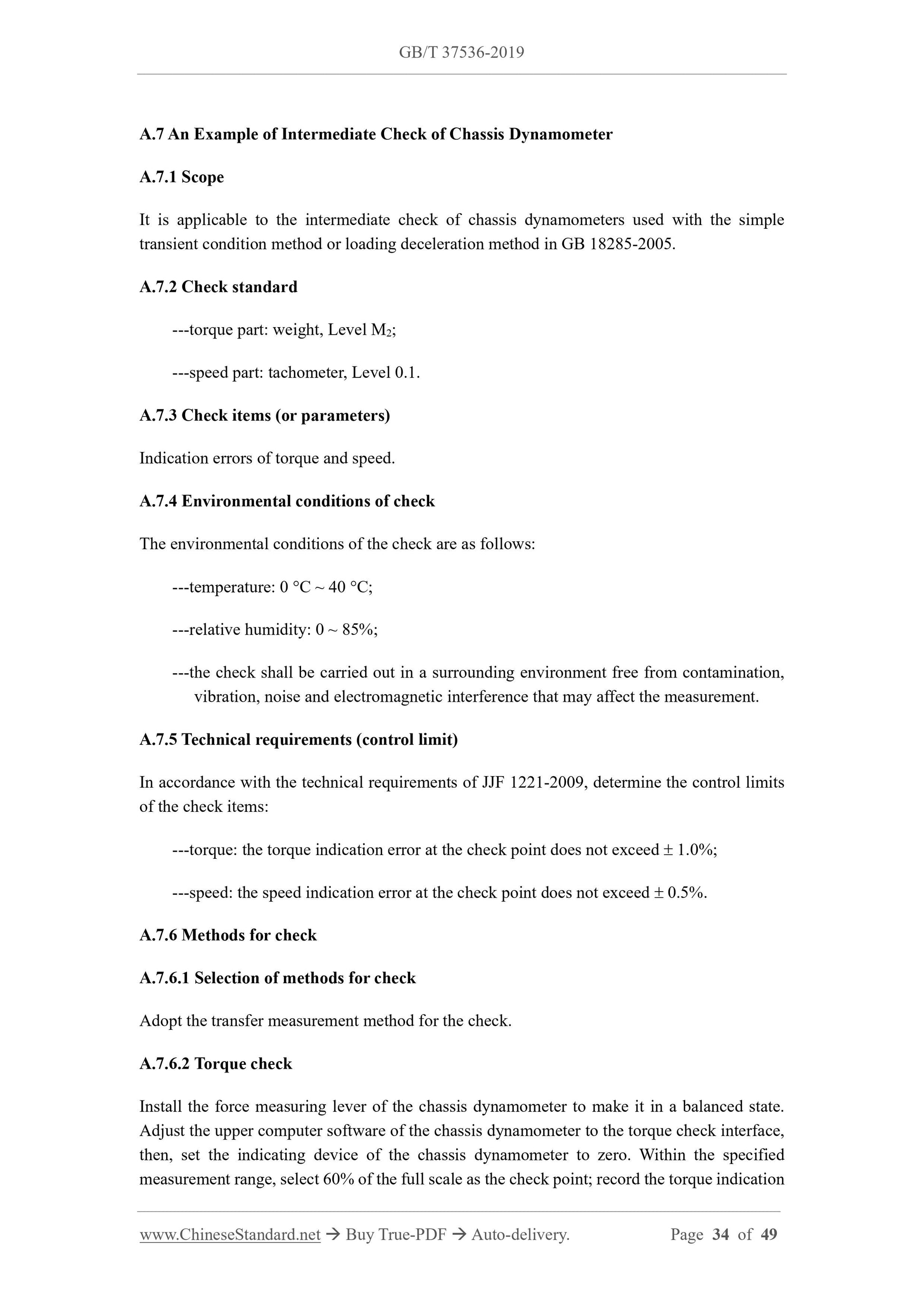PayPal, credit cards. Download editable-PDF and invoice in 1 second!
GB/T 37536-2019 English PDF (GBT37536-2019)
GB/T 37536-2019 English PDF (GBT37536-2019)
Precio habitual
$500.00 USD
Precio habitual
Precio de oferta
$500.00 USD
Precio unitario
/
por
Los gastos de envío se calculan en la pantalla de pago.
No se pudo cargar la disponibilidad de retiro
Delivery: 3 seconds. Download true-PDF + Invoice.
Get QUOTATION in 1-minute: Click GB/T 37536-2019
Historical versions: GB/T 37536-2019
Preview True-PDF (Reload/Scroll if blank)
GB/T 37536-2019: Intermediate check specifications of measuring equipment for vehicle inspection body
GB/T 37536-2019
NATIONAL STANDARD OF THE
PEOPLE’S REPUBLIC OF CHINA
ICS 43.180
R 17
Intermediate Check Specifications of Measuring Equipment
for Vehicle Inspection Body
ISSUED ON: JUNE 4, 2019
IMPLEMENTED ON: JANUARY 1, 2020
Issued by: State Administration for Market Regulation;
Standardization Administration of the People’s Republic of China.
Table of Contents
Foreword ... 3
1 Scope ... 4
2 Normative References ... 4
3 Terms and Definitions ... 4
4 Basic Requirements for Intermediate Check ... 5
5 Determination Principles for Intermediate Check Objects ... 6
6 Methods for Intermediate Check ... 6
7 Result Determination Principles and Processing of Intermediate Check ... 11
8 Records and Reports ... 12
Appendix A (Informative) Some Examples of Intermediate Check of Measuring
Equipment ... 13
Appendix B (informative) Examples of Intermediate Check Reports with Commonly
Used Intermediate Check Methods ... 44
Bibliography ... 48
Intermediate Check Specifications of Measuring Equipment
for Vehicle Inspection Body
1 Scope
This Standard specifies the basic requirements, determination principles for check objects,
methods for intermediate check, result determination principles and processing, as well as
records and reports of intermediate check of measuring equipment for vehicle inspection body
(hereinafter referred to as “intermediate check”).
This Standard applies to intermediate check conducted by vehicle inspection body on in-use
measuring equipment.
2 Normative References
The following documents are indispensable to the application of this document. In terms of
references with a specified date, only versions with a specified date are applicable to this
document. In terms of references without a specified date, the latest version (including all the
modifications) is applicable to this document.
GB/T 4091 Shewhart Control Charts
GB 7258 Technical Specifications for Safety of Power-driven Vehicles Operating on Roads
GB 18565 Composite Performance Requirement and Detecting Methods for Road Transport
Vehicles
JJF 1001 General Terms in Metrology and Their Definitions
RB/T 218 Competence Assessment for Inspection Body and Laboratory Mandatory Approval -
Requirements for Vehicles Inspection Body
3 Terms and Definitions
What is defined in GB 7258, GB 18565, JJF 1001 and RB/T 218, and the following terms and
definitions are applicable to this document.
3.1 Vehicle Safety Technology Inspection
Vehicle safety technology inspection refers to the activities of inspecting motor vehicles
operating on roads, including registration inspection of motor vehicles and inspection of in-use
motor vehicles pursuant to the Law of the People’s Republic of China on Road Traffic Safety
and the regulations for its implementation, and in accordance with the requirements of national
safety technology standards for motor vehicles.
3.2 Vehicle Emission Inspection
Vehicle emission inspection refers to the activities of conducting emission inspection on in-use
motor vehicles pursuant to the stipulations of the Law of the People’s Republic of China on the
Prevention and Control of Air Pollution, and in accordance with the standards and
specifications formulated by the environmental protection authority.
3.3 Automotive Multiple-function Inspection
Automotive multi-function inspection refers to the activities of inspecting the combination of
multiple technical properties, such as: vehicle dynamic quality, safety, fuel economy, service
reliability, exhaust pollutants and noise, as well as the completeness and status of vehicle
equipment, pursuant to the stipulations of the Regulations on the Administration of Road
Transport Vehicles, and in accordance with the standards and specifications formulated by the
competent transportation department of the State Council.
3.4 Vehicle Inspection
Vehicle inspection is a general term for three types of inspection activities: vehicle safety
technology inspection, vehicle emission inspection and automotive multiple-function
inspection.
3.5 Vehicle Inspection Body
Vehicle inspection body is a general term for inspection institutions engaged in three types of
inspection activities: vehicle safety technology inspection, vehicle emission inspection and
automotive multiple-function inspection.
3.6 Intermediate Check
Intermediate check refers to an operation carried out in accordance with the prescribed
procedures to determine whether the measuring equipment remains in the state at the time of
its verification / calibration.
4 Basic Requirements for Intermediate Check
4.1 The intermediate check shall be carried out in accordance with the prescribed procedures
and the formulated check plans.
4.2 The vehicle inspection body shall confirm the measuring instruments and equipment, select
the methods for checking and determining the frequency of checking in the intermediate check
plans.
4.3 The vehicle inspection body shall check certain parameters, ranges or measurement points
term stability, the shewhart control chart method may be used to perform the intermediate check
on the instruments and equipment. Usually, the instruments and equipment being checked are
used to periodically perform repeated measurements on the check standards, or the check
standards are used to periodically perform repeated measurements on the instruments and
equipment being checked, and the obtained characteristic values are used to draw the average
value control chart or the range control chart.
7 Result Determination Principles and Processing of
Intermediate Check
7.1 Determination Principles and Processing of Transfer Measurement Method
and Reference Substance Method
7.1.1 If Formula (1) or Formula (2), Formula (3) or Formula (4) is established, then, the result
passes the current check. It suggests that the measuring equipment remains in the state at the
time of its verification or calibration, is in a controlled state and can continue to be used.
7.1.2 Otherwise, Formula (1) or Formula (2), Formula (3) or Formula (4) do not hold, and the
result fails the current check. It suggests that the technical indicators of the measuring
equipment exceed the expected requirements of use, and that the equipment shall be
immediately stopped. The inspection body shall analyze the abnormalities of the technical
conditions of the measuring equipment being checked, and find out the reasons. The methods
for the check may be replaced, and the check points may be added. If necessary, repair or
replacement shall be performed for re-verification or re-calibration.
7.2 Determination Principles and Processing of Multi-set Comparison Method,
Two-set Comparison Method and Check Standard Method
7.2.1 When En 0.7, the intermediate check result satisfies the requirements, indicating that the
measuring equipment remains in the state at the time of its verification or calibration, is in a
controlled state and can continue to be used.
7.2.2 When 0.7 < En 1, the intermediate check result satisfies the requirements, but there is a
risk trend. The inspection body shall analyze the measuring equipment, find out the reasons,
strengthen maintenance and tracking, and increase the frequency of check.
7.2.3 When En > 1, the result fails the current intermediate check, indicating that the technical
indicators of the measuring equipment exceed the expected requirements of use, and that the
equipment shall be immediately stopped. The insp...
Get QUOTATION in 1-minute: Click GB/T 37536-2019
Historical versions: GB/T 37536-2019
Preview True-PDF (Reload/Scroll if blank)
GB/T 37536-2019: Intermediate check specifications of measuring equipment for vehicle inspection body
GB/T 37536-2019
NATIONAL STANDARD OF THE
PEOPLE’S REPUBLIC OF CHINA
ICS 43.180
R 17
Intermediate Check Specifications of Measuring Equipment
for Vehicle Inspection Body
ISSUED ON: JUNE 4, 2019
IMPLEMENTED ON: JANUARY 1, 2020
Issued by: State Administration for Market Regulation;
Standardization Administration of the People’s Republic of China.
Table of Contents
Foreword ... 3
1 Scope ... 4
2 Normative References ... 4
3 Terms and Definitions ... 4
4 Basic Requirements for Intermediate Check ... 5
5 Determination Principles for Intermediate Check Objects ... 6
6 Methods for Intermediate Check ... 6
7 Result Determination Principles and Processing of Intermediate Check ... 11
8 Records and Reports ... 12
Appendix A (Informative) Some Examples of Intermediate Check of Measuring
Equipment ... 13
Appendix B (informative) Examples of Intermediate Check Reports with Commonly
Used Intermediate Check Methods ... 44
Bibliography ... 48
Intermediate Check Specifications of Measuring Equipment
for Vehicle Inspection Body
1 Scope
This Standard specifies the basic requirements, determination principles for check objects,
methods for intermediate check, result determination principles and processing, as well as
records and reports of intermediate check of measuring equipment for vehicle inspection body
(hereinafter referred to as “intermediate check”).
This Standard applies to intermediate check conducted by vehicle inspection body on in-use
measuring equipment.
2 Normative References
The following documents are indispensable to the application of this document. In terms of
references with a specified date, only versions with a specified date are applicable to this
document. In terms of references without a specified date, the latest version (including all the
modifications) is applicable to this document.
GB/T 4091 Shewhart Control Charts
GB 7258 Technical Specifications for Safety of Power-driven Vehicles Operating on Roads
GB 18565 Composite Performance Requirement and Detecting Methods for Road Transport
Vehicles
JJF 1001 General Terms in Metrology and Their Definitions
RB/T 218 Competence Assessment for Inspection Body and Laboratory Mandatory Approval -
Requirements for Vehicles Inspection Body
3 Terms and Definitions
What is defined in GB 7258, GB 18565, JJF 1001 and RB/T 218, and the following terms and
definitions are applicable to this document.
3.1 Vehicle Safety Technology Inspection
Vehicle safety technology inspection refers to the activities of inspecting motor vehicles
operating on roads, including registration inspection of motor vehicles and inspection of in-use
motor vehicles pursuant to the Law of the People’s Republic of China on Road Traffic Safety
and the regulations for its implementation, and in accordance with the requirements of national
safety technology standards for motor vehicles.
3.2 Vehicle Emission Inspection
Vehicle emission inspection refers to the activities of conducting emission inspection on in-use
motor vehicles pursuant to the stipulations of the Law of the People’s Republic of China on the
Prevention and Control of Air Pollution, and in accordance with the standards and
specifications formulated by the environmental protection authority.
3.3 Automotive Multiple-function Inspection
Automotive multi-function inspection refers to the activities of inspecting the combination of
multiple technical properties, such as: vehicle dynamic quality, safety, fuel economy, service
reliability, exhaust pollutants and noise, as well as the completeness and status of vehicle
equipment, pursuant to the stipulations of the Regulations on the Administration of Road
Transport Vehicles, and in accordance with the standards and specifications formulated by the
competent transportation department of the State Council.
3.4 Vehicle Inspection
Vehicle inspection is a general term for three types of inspection activities: vehicle safety
technology inspection, vehicle emission inspection and automotive multiple-function
inspection.
3.5 Vehicle Inspection Body
Vehicle inspection body is a general term for inspection institutions engaged in three types of
inspection activities: vehicle safety technology inspection, vehicle emission inspection and
automotive multiple-function inspection.
3.6 Intermediate Check
Intermediate check refers to an operation carried out in accordance with the prescribed
procedures to determine whether the measuring equipment remains in the state at the time of
its verification / calibration.
4 Basic Requirements for Intermediate Check
4.1 The intermediate check shall be carried out in accordance with the prescribed procedures
and the formulated check plans.
4.2 The vehicle inspection body shall confirm the measuring instruments and equipment, select
the methods for checking and determining the frequency of checking in the intermediate check
plans.
4.3 The vehicle inspection body shall check certain parameters, ranges or measurement points
term stability, the shewhart control chart method may be used to perform the intermediate check
on the instruments and equipment. Usually, the instruments and equipment being checked are
used to periodically perform repeated measurements on the check standards, or the check
standards are used to periodically perform repeated measurements on the instruments and
equipment being checked, and the obtained characteristic values are used to draw the average
value control chart or the range control chart.
7 Result Determination Principles and Processing of
Intermediate Check
7.1 Determination Principles and Processing of Transfer Measurement Method
and Reference Substance Method
7.1.1 If Formula (1) or Formula (2), Formula (3) or Formula (4) is established, then, the result
passes the current check. It suggests that the measuring equipment remains in the state at the
time of its verification or calibration, is in a controlled state and can continue to be used.
7.1.2 Otherwise, Formula (1) or Formula (2), Formula (3) or Formula (4) do not hold, and the
result fails the current check. It suggests that the technical indicators of the measuring
equipment exceed the expected requirements of use, and that the equipment shall be
immediately stopped. The inspection body shall analyze the abnormalities of the technical
conditions of the measuring equipment being checked, and find out the reasons. The methods
for the check may be replaced, and the check points may be added. If necessary, repair or
replacement shall be performed for re-verification or re-calibration.
7.2 Determination Principles and Processing of Multi-set Comparison Method,
Two-set Comparison Method and Check Standard Method
7.2.1 When En 0.7, the intermediate check result satisfies the requirements, indicating that the
measuring equipment remains in the state at the time of its verification or calibration, is in a
controlled state and can continue to be used.
7.2.2 When 0.7 < En 1, the intermediate check result satisfies the requirements, but there is a
risk trend. The inspection body shall analyze the measuring equipment, find out the reasons,
strengthen maintenance and tracking, and increase the frequency of check.
7.2.3 When En > 1, the result fails the current intermediate check, indicating that the technical
indicators of the measuring equipment exceed the expected requirements of use, and that the
equipment shall be immediately stopped. The insp...
Share
